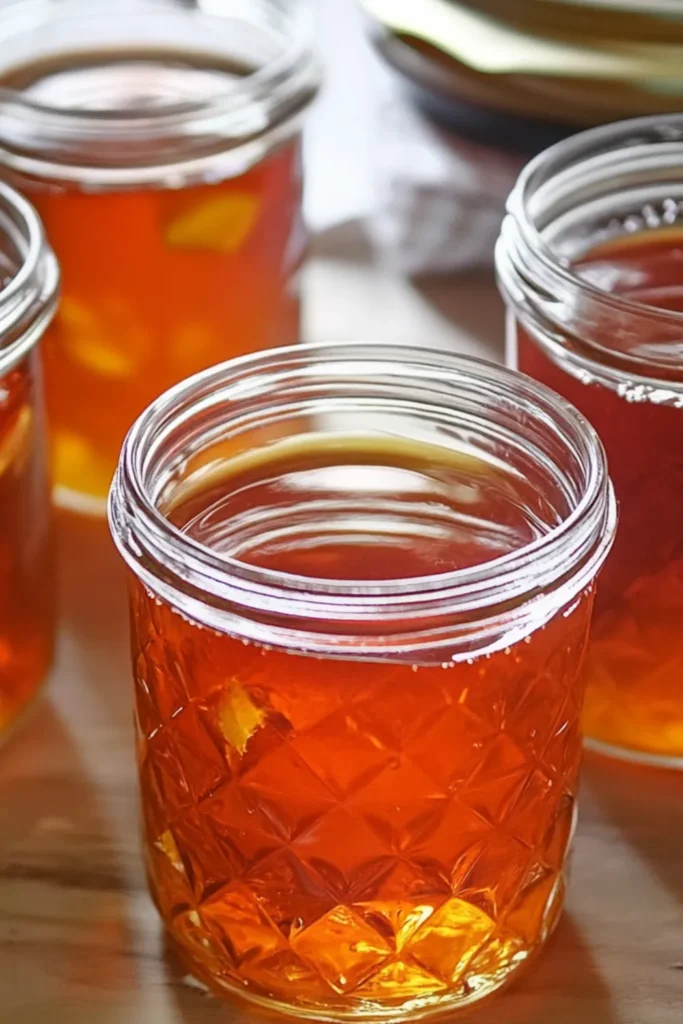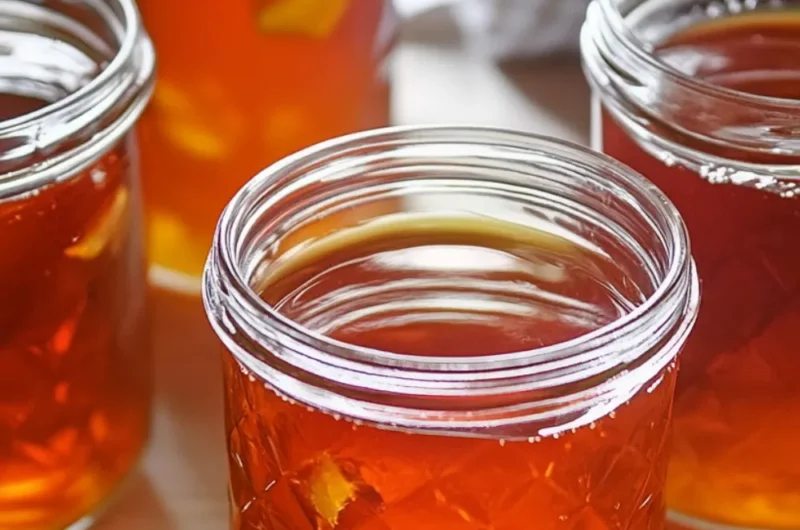This homemade quince jelly is sweet, smooth, and perfect for toast or cheese boards. It’s made by cooking fresh quince, straining the juice, and boiling it with sugar until it sets into a shiny jelly. It looks fancy, but it’s easy if you follow each step.
Jump to RecipeIngredients Needed:
- 3 1/2 pounds (1.6 kg) quince, washed, stems removed, cored, quartered (leave the skin on)
- 7 cups (1.6 liters) water
- About 4 cups sugar (enough to add about 7/8 cup for every 1 cup juice)
How To Make Quince Jelly Recipe?
- Cook the quince: Place the quince in a large pot and add enough water to cover them by about 1 inch. Bring to a boil, then reduce heat, cover, and simmer for 45 minutes to 1 hour until soft.
- Mash the fruit: mash the cooked quince with a potato masher until it looks like runny applesauce. Add a little more water if it’s too thick.
- Strain the juice: place a strainer over a pot and line it with 2 layers of cheesecloth. Spoon in the mashed quince and let the juice drip through for 3 to 4 hours. If needed, mix in more water to help it drain.
- Measure juice and add sugar: measure how much juice you have (usually 4 to 5 cups). Pour it into a clean pot. Add just under 1 cup of sugar for every 1 cup of juice. Bring to a boil while stirring until the sugar dissolves.
- Boil the jelly: let it boil and skim off any foam that rises. Use a candy thermometer and cook until it reaches about 218°F to 220°F. This is when the jelly will start to set.
- Test for setting: put a small spoon of jelly on a cold plate from the freezer. Wait a few seconds, then push it with your finger. If it wrinkles, it’s ready.
- Sterilize jars: while the jelly cooks, wash jars, lids, and rings in hot soapy water. Boil jars in a water bath for 10 minutes to sterilize.
- Fill and seal jars: pour the hot jelly into the jars, leaving a little space at the top. Seal with lids and rings. Place jars in a water bath canner for 5 minutes, then remove and let cool.

Recipe Tips:
- Keep the skin on the quince: the skin has natural pectin, which helps the jelly set. Don’t peel the fruit—it also adds color to the jelly.
- Mash the fruit while it’s still warm: it’s much easier to mash when hot. Cold quince mash gets thick and harder to work with.
- Strain slowly for clear jelly: don’t press or squeeze the mash through the cloth. Let it drip naturally for 3 to 4 hours. Pressing can make the jelly cloudy.
- Use the right sugar amount: measure the juice first, then add just under 1 cup of sugar per 1 cup of juice. This helps it set properly and taste just right.
- Watch the temperature closely: quince jelly sets between 218°F and 220°F. Use a candy thermometer or test with a cold plate to avoid undercooking or overcooking.
How To Store Leftovers?
Let the quince jelly cool to room temperature. Store sealed jars in a cool, dry place for up to 1 year. Once opened, keep the jar in the fridge and use it within 6 months.
Nutrition Facts:
- Calories: 60 kcal
- Total Fat: 0g
- Saturated Fat: 0g
- Cholesterol: 0mg
- Sodium: 0mg
- Potassium: 15mg
- Total Carbohydrate: 16g
- Dietary Fiber: 0g
- Sugars: 16g
- Protein: 0g
Try More Delia Smith Recipes:
Delia Smith Quince Jelly Recipe
Course: DessertCuisine: BritishDifficulty: Easy6
servings20
minutes1
hour60
kcalThis homemade quince jelly is sweet, smooth, and perfect for toast or cheese boards. It’s made by cooking fresh quince, straining the juice, and boiling it with sugar until it sets into a shiny jelly. It looks fancy, but it’s easy if you follow each step.
Ingredients
3 1/2 pounds (1.6 kg) quince, washed, stems removed, cored, quartered (leave the skin on)
7 cups (1.6 liters) water
About 4 cups sugar (enough to add about 7/8 cup for every 1 cup juice)
Directions
- Cook the quince: Place the quince in a large pot and add enough water to cover them by about 1 inch. Bring to a boil, then reduce heat, cover, and simmer for 45 minutes to 1 hour until soft.
- Mash the fruit: mash the cooked quince with a potato masher until it looks like runny applesauce. Add a little more water if it’s too thick.
- Strain the juice: place a strainer over a pot and line it with 2 layers of cheesecloth. Spoon in the mashed quince and let the juice drip through for 3 to 4 hours. If needed, mix in more water to help it drain.
- Measure juice and add sugar: measure how much juice you have (usually 4 to 5 cups). Pour it into a clean pot. Add just under 1 cup of sugar for every 1 cup of juice. Bring to a boil while stirring until the sugar dissolves.
- Boil the jelly: let it boil and skim off any foam that rises. Use a candy thermometer and cook until it reaches about 218°F to 220°F. This is when the jelly will start to set.
- Test for setting: put a small spoon of jelly on a cold plate from the freezer. Wait a few seconds, then push it with your finger. If it wrinkles, it’s ready.
- Sterilize jars: while the jelly cooks, wash jars, lids, and rings in hot soapy water. Boil jars in a water bath for 10 minutes to sterilize.
- Fill and seal jars: pour the hot jelly into the jars, leaving a little space at the top. Seal with lids and rings. Place jars in a water bath canner for 5 minutes, then remove and let cool.
Notes
- Keep the skin on the quince: the skin has natural pectin, which helps the jelly set. Don’t peel the fruit—it also adds color to the jelly.
- Mash the fruit while it’s still warm: it’s much easier to mash when hot. Cold quince mash gets thick and harder to work with.
- Strain slowly for clear jelly: don’t press or squeeze the mash through the cloth. Let it drip naturally for 3 to 4 hours. Pressing can make the jelly cloudy.
- Use the right sugar amount: measure the juice first, then add just under 1 cup of sugar per 1 cup of juice. This helps it set properly and taste just right.
- Watch the temperature closely: quince jelly sets between 218°F and 220°F. Use a candy thermometer or test with a cold plate to avoid undercooking or overcooking.

